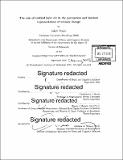The role of cortical layer six in the perception and laminar representation of sensory change
Author(s)
Voigts, Jakob
DownloadFull printable version (19.25Mb)
Other Contributors
Massachusetts Institute of Technology. Department of Brain and Cognitive Sciences.
Advisor
Christopher I. Moore and Emery N Brown.
Terms of use
Metadata
Show full item recordAbstract
Neocortex learns predictive models of sensory input, allowing mammals to anticipate future events. A fundamental component of this process is the comparison between expected and actual sensory input, and the layered architecture of neocortex is presumably central to this computation. In this thesis, I examine the role of laminar differences, and specifically the role of layer 6 (L6) in the encoding and perception of stimuli that deviate from previous patterns. In awake mice, layer 4 neurons encode current stimulus deviations with a predominantly monotonic, faithful encoding, while neurons in layer 2/3 encode history dependent change signals with heterogeneous receptive fields. Corticothalamic (CT) cells in Layer 6 respond sparsely, but faithfully encode stimulus identity. Weak optogenetic drive of L6 CT cells disrupted this encoding in layer 6 without affecting overall firing rates. This manipulation also caused layer 2/3 to represent only current stimuli. In a head-fixed stimulus detection task, small stimulus deviations typically make stimuli more detectable, and the L6 manipulation removed this effect, without affecting detection of non-changing stimuli. Analogously, in free sensory decision making behavior, the manipulation selectively impaired perception of deviant stimuli, without affecting basic performance. In contrast, stronger L6 drive reduced sensory gain and impaired tactile sensitivity. These results show an explicit laminar encoding of stimulus changes, and that L6 can play a role in the perception of sensory changes by modulating responses depending on previous, or expected input. This finding provides a new perspective on how the layered cortical architecture can implement computations on hierarchical models of the world.
Description
Thesis: Ph. D., Massachusetts Institute of Technology, Department of Brain and Cognitive Sciences, February 2017. Cataloged from PDF version of thesis. "September 2016." Includes bibliographical references.
Date issued
2017Department
Massachusetts Institute of Technology. Department of Brain and Cognitive SciencesPublisher
Massachusetts Institute of Technology
Keywords
Brain and Cognitive Sciences.